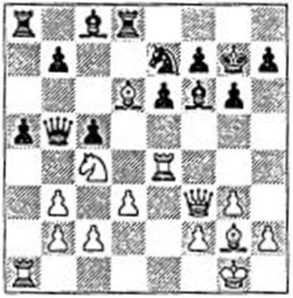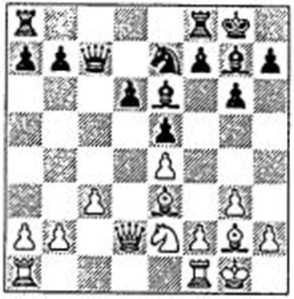Opening Preparation
Mark Dvoretsky and Artur Yusupov
With contributions from:
Sergei Dolmatov
Yuri Razuvaev
Boris Zlotnik
Aleksei Kosikov
Vladimir Vulfson
Translated by Joint Sugden
В. T. Batsford Ltd, London
First published 1994
© Mark Dvoretsky. Artur Yusupov 1994 Reprinted 1994, 1996 ISBN 0 7134 7509 9
British Library Cataloguing-in-Publication Data. A CIP catalogue record for this book is available from the British Library.
Ail rights reserved. No part of this book may be reproduced, by any means, without prior permission of the publisher.
Typeset by John Nunn GM and printed in Great Britain by Redwood Books, Trowbridge, Wilts for the publishers, В. T. Batsford Ltd, 4 Fitzhardinge Street, London W1H0AH
A BATSFORD CHESS BOOK
Editorial Panel: Mark Dvoretsky, John Nunn, Jon Speclman
General Adviser: Raymond Keene OBE
Commissioning Editor: Graham Burgess
Threatening 25 h5.
25 g4
White needs to play Дс4 and Egl, but which move should come first? When realising an advantage, close attention must be paid to the opponent's counter-chances. The natural-looking 28 Дс4? is tactically refuted by 28...Exc6 29 be Дхе5‘. 30 fc 'йхеЗ-*-, with threats of
31...Wxb2+ and31...f5.
28 Egl!
White has a decisive advantage, which he conducted to victory.
When playing a system that suits you with Black with colours reversed, you can hardly ever borrow any concrete variations directly from the normal form of the opening. On the other hand, as I hope to have shown, you can in a broad sense utilise your knowledge of the typical plans, devices and assessments. Indeed it is generally true that to acquire a deep understanding of any opening, the study of overall ideas is at least as important as the memorising of specific variations.
It sometime^ happens that to solve the problems of one opening, you make use of precepts characteristic of an entirely different system. It follows that a practical player should not confine himself to studying games played with ‘his own' openings. You should select any well annotated games for study, even if the openings are wholly foreign to your repertoire. In this way you will not be extending your repertoire directly, but perhaps some game will serve as a pointer towards doing so. The main thing is that you will increase your stock of positional ideas, resources and judgements, which, xs I have said, can be applied in the most varied contexts when appropriate. Ideas that appeal to you should be recorded in the form of ‘positional images', which we discussed during the previous session of the school.
Nczhmetdinov-Amateur (1951)
13 Wb31! 'S'xal (I3...'tfxb3 14 &xd7+ and 15 ab, with an extra piece for White) 14 ДЬ2 Wbl 15 £jf3! Wxhl 16 £lc5 (threatening mate in one) 16...c6 17 Axd7+ Sxd7 18 Bb8+ Sd8 (18...Фе7 19 <£c6 mate) 19 1»Ь5+ with a decisive attack.
The game concluded: 19.„Фс7 20 &Ъ7+ ±f6 21 ^xf7+ <d?g5 22 £f3+ <*h5 23 g4+! tf?xg4 24 Wxc6+ ФГ4 25 Дс5+ Фхс4 26 *£g5 mate.
Dvoretsky-Veselovsky (1967)
White's plan is clear: play on the qucensidc. In a suitable order, he intends Wa4, ДзЗ. Sb6/b8 etc.
In carrying out a plan, it is essential to take account of the opponent's intentions. What does Black want here? Obviously it would pay him to relieve the pressure on his queensidc by playing 17...ДЬЗ to exchange off the light-squared bishops. For this reason, the natural-looking 17 Wa4? would be a serious inaccuracy.
The bishop exchange can easily be avoided by 17 3c 1. But otherwise this move is no use to White - it doesn't fit into his plan.
The strongest continuation is 17 ДаЗ!. Increasing the pressure on the qucensidc. White simultaneously preserves his light-squared bishop from exchange. It is precisely moves like this - combining furtherance of your own plan with prophylaxis against that of the opponent - that in Nimzowitsch's view constitute the essence of true positional play.
Black only lasted a few more moves: 17...3fc8 18 o'a 4 Wc7 19 SaS f5? (19.. Sd7, with a view to 2O...d5, was more logical; I would probably have replied 20 3b8 d5 21 31Ы de 22 31b7) 20 3b8 Д.Г8 21 ДЬ4 Wa7 22 Sal <d7 23 Заб Д.Г7 24 Да5 1-0. In the final position, the
queenside domination by White's pieces is truly picturesque.
17 tff3 £g7
18 3e4?!
White could already have played the combination he plays next move.
18 ... Sd8 (93)
(The following games were mentioned in the lecture; they will give you a fuller idea of the opening variations discussed.)
Pctrosian-Pachman
Bled 1961
King's Indian Attack
|
1 |
£f3 |
cS |
|
2 |
g3 |
®c6 |
|
3 |
Ag2 |
g6 |
|
4 |
0-0 |
£g7 |
|
5 |
d3 |
e6 |
|
6 |
c4 |
£>gc7 |
|
7 |
Sei |
0-0?! |
As wc have already seen, 7...d6 should be played here.
|
8 |
eS! |
d6 |
|
9 |
ed |
e'xd6 |
|
10 |
£bd2 |
Wcl |
|
11 |
Qb3! |
£d4? |
Better is H...b6 12ДГ4'«Ъ7.
12 ДГ4 ЙЪб
13 £>e5 ФхЬЗ
14 £k4!
More precise than 14 ab ^d5 15 £ic4 й'сб.
14 ... «Ъ5
14...Vd8 15 ab, with threats of 16 JLd6 and 16 Za5.
IS ab a5
The threat was 16 3a5.
16 ^d6 ДГ6
93
17

|
19 |
^xf6+! |
ФхГб |
|
20 |
AeS+ |
Ф&5 |
|
21 |
-S-g7! |
1-0 |
Smyslov-Denker Match USSR-USA. Moscow 1946 Sicilian
|
1 |
e4 |
cS |
|
2 |
ФеЗ |
4k6 |
|
3 |
g3 |
g<5 |
|
4 |
Ag2 |
£g7 |
|
5 |
d3 |
c6 |
|
6 |
ДеЗ |
Qd4?! |
|
7 |
£tec2! |
d6 |
|
8 |
c3 |
£c6 |
8...£>xe2 looks more natural.
9 d4 cd
10 £xd4!
White needs to recapture with piece so that he can later exploit th weak d-pawn.
10 £)xd4
Better is 11...41f6.
14 0-0 Деб
15 *'d2 Wc7 (94)
15...d5 fails to 16 Дс5.
94 iv

16 Sfcl!
To consolidate his hold on d5, White has to prepare c3-c4. 16 b3, with the same objective, would be weaker in view of 16...b5 (17 a4 ba 18 Exa4 ДхЬЗ). Now, however, 16...b5 can be met by 17 a4! a6 (17...ba 18 Sxa4 a5 19 Zeal, threatening 20 b4) 18 3dl, e.g: 18...Ead8 19 ab ab 20Ea7', or 18...Sfd8 19 ab ab 20 Exa8 Exa8 21 O'xd6; or 18...ДЬЗ 19 Wxd6 Wxd6 20 Sxd6 Дха4 21 43c 1, preparing 22 b3.
17 c4
18...Дхс4 1943xe4d5 2043g5! is dangerous for Black.
19...43d4 is met by 20 c5! d5 21 43g5 ДП 22 f4 with an attack.
21...Дхс4 22 Each
22 Zacl
White is aiming for an advantageous exchange of light-squared bishops. 24...ФЬ7 can be answered by 25 Дс4! (with the idea of 26 h4), or by 25 43b5 and 26 Wd3.